History of the NHDOC
Chronological History
The New Hampshire State Prison and the Department of Corrections has a long, fascinating history. It begins only 34 years after the signing of the Declaration of Independence. Here are some highlights:
1811
Another $18,000.00 was appropriated for the project for modifications to expand it to four stories.
1812
The building was completed and occupied by a single inmate.
1819
$2,600.00 was appropriated "for the erection and completion of a work-shop for the convicts in the State Prison." This was the forerunner of the modern prison industries program.
1831
Another $3,000.00 was allotted "for the purpose of erecting a new State Prison on the land now occupied…for a State's Prison." This was actually a new wing with another 127 cells. It was completed in 1832.
1860
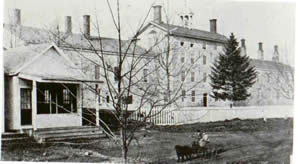 This is a photo of the original New Hampshire State prison ca. 1860
This is a photo of the original New Hampshire State prison ca. 1860
1869
Josiah L. Pike is the first New Hampshire prisoner executed.
1874
Governor James A. Weston and the Executive Council appoint a three-member committee to study the need for, costs, and proposed location for a new state prison. The final report cited deteriorating conditions, problems with discipline, and consistently large expenses for repairs. It was determined "a substantial building upon some other site cannot be wisely and safely delayed."
1877
The Legislature produced "An act providing for the erection of a new state-prison." Three commissioners were appointed to procure plans and specifications for a new prison, with all-necessary offices and work-shops. The cost was not to exceed $200,000 and be sufficient to accommodate and employ 200 convicts.
--By November, the units of the institution were outlined as 1. Dwelling, 2. Central of main building, 3. North Wing, 4. South Wing, 5. West Wing, 6. Workshop, and 7. Wall and yard.
1878
Ground was broken on May 3, 1878. Funding was allotted for 47 additional cells.
1880
The new prison was occupied by November. Warden Frank Dodge declared, "I take pride in claiming for our state one of the best built and most convenient prisons of modern world."
Within months, the physical and moral condition of the prisoners had much improved. No significant changes would be made to the physical structure for many years to come.
1884
The first federal prisoners are held at the prison.
1885
Other buildings completed. These include a new stable, tenement houses, wood shed, and a front fence.
1890
A fire damages the top of the building down to the chapel. There is also damage to the hospital floors and the South Wing. A spark from a shop chimney caused it. Damage estimates were $6,954.42
1902
Internal improvements are made including a new laundry vent, eight new bathtubs, and protective porches over the yard entrances (against falling ice and snow.).
1906
A new prison school for illiterates is established. First inmate was paroled.
1908
Governor Charles M. Floyd and the Executive Council abolish red and black striped prison uniforms in favor of gray.
1910
Prison cells fitted with electric lights. To this point, candles had been used.
1914
In July there was a disastrous fire in the ward outside the walls. 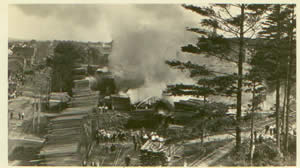
1917
For the first time inmates were paid a daily stipend to work on contracted projects in Prison Industries. The rate of pay was ten cents per day.
1921
Radios are installed in the prison cells with "fine entertainment…coming to us from as far as New York and Pennsylvania."
1926
The State Department of Education is enlisted to assist the educational program of the prison.
1932
The Legislature appropriates $200,000.00 for the establishment of new industries. The license plate shop, sign shop, the print shop and the farm are seen as the most promising fields. Also, the first conditional pardon was granted to an inmate.
To the right, the original license plate shop. 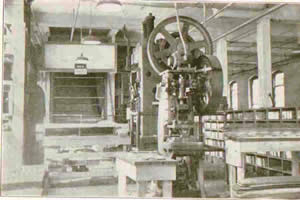
1934
Individual sanitary facilities installed in each inmate cell. Industries established.
1938
Prison farm purchased.
New infirmary and dental office built.
1939
Howard Long is the last New Hampshire inmate executed to date.
1941
World War II creates challenges hiring officers. Fuel conservation for the war effort closes a new cellblock. Difficult steel acquisition closes the Tile Plant.
1949
Much of the prison was completely repainted and the Warden's residence was renovated. New parking facilities were added. Much landscaping was done. Many of the trees planted this year are still on the prison grounds today.
1950
Inmate classification system instituted at the prison. This allowed for safer and fair distribution of prison population throughout housing units.
1951
Alcoholics Anonymous was introduced in the prison.
1952
Stainless steel tables were installed in the dining room to replace wooden tables installed in 1919.
1954
Considerable renovations were undertaken. The control room, officer's room, and visiting room were renovated and upgraded. Electric doors installed. New laundry and kitchen equipment was installed. A new library was constructed. Many units were completely re-wired.
1956
Warden and Deputy warden's residences converted to administrative office space as inmate population grows.
1961
The southwest corner of the old prison yard is converted into a 90' x 60' multi-purpose inmate recreation area.
1962
The New England Interstate Corrections Compact is created thus allowing for the transfer of inmates to other states.
1965
To the right - Prison Industries Building in 1965. 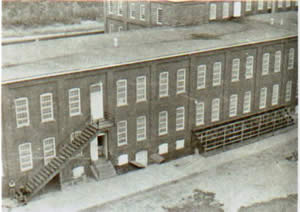
1965
The first television is installed in the recreation room for inmate use.
1967
The Community Release Law is passed by the Legislature allowing the Warden to release any inmate in custody to seek gainful employment. Certain stipulations apply regarding the type of sentence the inmate is serving.
1969
First full-time educational director appointed.
1971
Warden and Deputy Warden residences are further converted to house expanding inmate treatment programs.
1973
Shea Farm Halfway House opens in Concord becoming the first housing unit to open off the grounds of the state prison. As inmates near their parole dates, they are housed here as they seek work and prepare to return to society.
1976
Auto repair shop is completed. Medical coverage is increased to 24 hours a day. Inmate law library purchased.
1977
Fire damages the roof of the prison recreation building. Arson was the cause.
1978
A 1970 lawsuit results in the Laamen Consent Decree. This requires the State Prison to provide adequate programming opportunities for inmates. While there would be many incarnations of the decree until the 1990's, steps are taken to expand and greatly improve programs.
1979
Calumet Halfway House opens in Manchester. The legislature appropriated $200,000.00 to acquire the historic building from the Catholic Diocese of Manchester. Inmate labor was used to bring it up to fire codes.
1980
State Prison staff now attending 12-day formal training sessions with NH Police Standards and Training Council. In-service and pre-service training greatly expanded.
1981
Hancock Recreation Field completed and dedicated. It includes a new security tower. Governor Hugh Gallen attends grand opening. Major new housing construction project begins. Also there are many significant renovations of the administrative offices, chapel, staff and inmate dining areas, and in inmate dormitories. Inmate labor used significantly for the work.
1982
Major construction work is underway on a new Special Housing and Close Custody Units to house maximum custody and punitive segregation inmates. 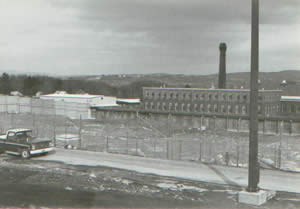
1983
The Department of Corrections is created by statute and becomes operational. Governor John H. Sununu and the Executive Council appoint Ronald L. Powell as Commissioner. This action consolidated the previously independent Probation Department, Parole Department, and the State Prison into one state agency.
1986
The Secure Psychiatric Unit opens. Medium Custody Units begin operating. Massive renovations and construction projects are completed and a vastly expanded prison is operating.
1989
The female facility opens in Goffstown. The DOC enters into a lease agreement with Hillsborough County to modify a building as a satellite unit of the men's prison in Concord.
1990
New Hampshire Department of Corrections becomes one of only three states to be fully accredited by the American Correctional Association for excellence in operation. The Shock Incarceration program opens. The 120-day intensive experience is designed as a diversion for inmates who have committed non-violent crimes. Also the Administrative Home Confinement program begins.
1991
The Lakes Region Facility in Laconia opens. The facility is a minimum/medium-security programming institution that opens on the grounds of the former New Hampshire State School for the developmentally disabled.
1994
On a cold winter's night a spectacular fire destroys the men's prison warehouse. The wooden structure dated to the early 20th Century. The fire smoldered for days and a cause was never satisfactorily determined (Right). Governor Steve Merrill and the Executive Council appoint Paul Brodeur as Commissioner. The NH-DOC Honor Guard is formed to represent the department at ceremonial functions. 
1996
June 7: 96 medium security inmates barricaded themselves inside the D-Pod of the Hancock Housing Unit damaging furniture and plumbing. One inmate suffered minor injuries. The 6 1/2-hour tense standoff ended when the prison's Special Emergency Response Team entered the unit and dispersed the group.
1997
Governor Jeanne Shaheen and the Executive Council appoint Henry Risley as Commissioner.
1998
Groundbreaking begins on construction of an adult prison in Berlin.
1999
Commissioner Risley dies in a plane crash.
2000
The Northern NH Correctional Facility opens in Berlin.
2001
Governor Jeanne Shaheen and the Executive Council appoint Jane Coplan as first female Warden of the men's prison.
Corrections Creations opens at its new location in the former prison stables. A large crowd of shoppers turns out for the grand opening ceremony.
On December 24, The Special Emergency Response Team (SERT) removes 16 inmates from their housing unit after they become disruptive.
2002
The Commissioner orders sweeping changes in the health services unit as medical costs continue to soar. More than 12% of the current inmate population is over the age of 50.
Long standing inmate programs get a makeover to better meet the needs of offenders. The classification process is streamlined. More emphasis is to be placed on substance abuse issues of newly arriving inmates.
2003
There is a budget proposal to consolidate the NH State Prison for Women with the Lakes Region Facility. After considerable public discussion, the legislature opts to keep the Goffstown facility open. A bill later passes in the legislature to further study the needs of female offenders.
In June, three inmates make a dramatic escape by cutting their way through the secure perimeter at the NH State Prison in Concord. They are apprehended one day later in Massachusetts after a nationwide search.
In October, Commissioner Phil Stanley steps down as Commissioner after a 3 1/2 year tenure.
2004
Governor Craig Benson and the Executive Council appoint Stephen J. Curry as Corrections Commissioner.
The Shea Farm Halfway House becomes an all-female facility to allow the department to provide programming specifically geared toward female offenders transitioning back into the community.
The 28 Day Parole Violator's Program is implemented. It is designed to provide parolees at risk of returning to prison with tools and resources to keep them out of prison.
2005
The New Hampshire Legislature forms a committee to study a complete reorganization of the department.
Work begins on implementing a statewide offender management database, which will provide the department with better information on offenders as they enter the system, participate in the system, and leave the system.
A foster kitten program is implemented at the NH State Prison for Women in association with the Animal Rescue League of New Hampshire. In the first six months more than fifty kittens were adopted from the program and placed in homes.
A service dog training program is implemented at the NH State Prison for Men in Concord.
Governor John H. Lynch and Executive Council appoint William L. Wrenn as Commissioner of Corrections.
2006
Inmates are evacuated from the Shea Farm Halfway House due to floods and road washouts. They return two days later.
The Department is court-ordered to implement a Residential Treatment Unit for inmates with mental health issues.
A major roofing project is completed at the NH State Prison in Concord. These are the first major renovations in over twenty years.
2007
A Residential Treatment Unit is implemented at the Secure Psychiatric Unit in Concord.
The Department hires a Female Programs Administrator in response to the growing population and an effort to develop more gender-specific programs.
Due to the growing female population the Department enters into a two year agreement with the Strafford County House of Corrections to house the overflow.
2008
The Department enters into a four year agreement with M-H-M of Vienna, Virginia to provide mental health services to the offender population.
The pre-service Corrections academy switches to a nine-week format in which officers attend the whole nine weeks while non-direct care civilian employees attend only part of it.
Funding was requested to construct a new female facility and female halfway house.
2009
The Lakes Region Facililty closed on June 30, 2009
2010
Governor Lynch signed the Justice Reinvestment Initiative into law.
2011
Prison population declines by 11.3% as a result of the 2010 Justice Reinvestment Initiative. Eight Corrections Counselors/Case Managers are assigned to four District Probation/Parole Offices to implement evidence-based treatment and programming.
The Bureau of Programs is consolidated under the Division of Community Corrections to promote a continuum of treatment and care from prison admission, throughout the offender's incarceration and parole supervision, until the sentence is concluded.
2012
A new 40 bed wing is opened in the Residential Treatment Unit in Concord to provide evidence-based care and treatment for qualified inmates.
2013
The New Hampshire Legislature allocated $38-million to design and construct a new women's prison in Concord.
2014
Governor Maggie Hassan joined Corrections officials for the groundbreaking ceremony for the New Hampshire Correctional Facility for Women
2017
Commissioner William Wrenn chooses not to seek reappointment. Assistant Commissioner Helen Hanks is sworn in as the new Commissioner.
2022
Through legislative initiatives, the Division of Community Corrections is renamed the Division of Rehabilitative Services and the Division of Security & Training is restructured to the Division of Personnel & Information.



